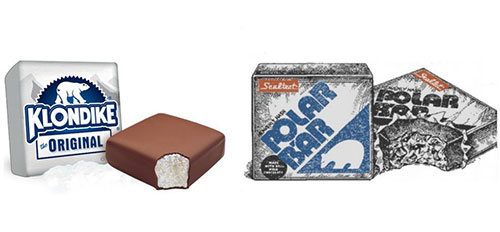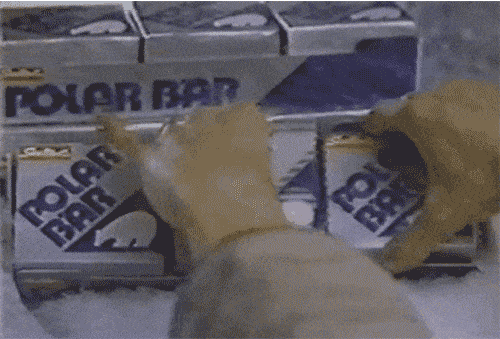Frozen Karma's Gonna Get You
The Klondike bar's catchy slogan isn't just marketing talk. The ice cream novelty was subject to a legal saga that nearly went to the Supreme Court.
"I never cease to stop thinking about Klondike, and every time I see one, even though it's someone else's product, if it's not straight in the freezer case, I find myself straightening them."
— Businessman Henry Clarke, who at one time owned the Klondike brand through his company Clabir, speaking about the experience in the book Klondikes, Chipped Ham, & Skyscraper Cones: The Story of Isaly's. Clarke turned the brand—at one time an obscure ice cream novelty that existed only in parts of Pennsylvania and Ohio—into a national success through smart marketing. Clarke was not a dairy man, really: Clabir, which was named after both himself and his mother, was an absurdly diversified company that included interests in both the dairy aisle and the defense industry—a formula that at one point gave the firm a buzz on Wall Street. Clarke, who died in 2013, was eventually forced to sell off the Klondike brand and its parent company Isaly, and was later kicked out of the company he founded.
Five People Who Were Willing to Commit Crimes for a Klondike Bar
- In 2009, a Florida man who really wanted a Klondike bar attempted to leave a store with a crushed Klondike bar in his back pocket, and after he was caught, he attempted to pay $69 for the bar—which the store generally sold for $1.29 each. Despite the willingness to pay more than usual, the dude was still arrested.
- Also in 2009, a couple of 16-year-olds ransacked and robbed a woman's house, stealing a cell phone, money, and a $3 bill. Oh, and one of the kids stole a box of Klondike bars. The incident, which took place near Pittsburgh, was quickly resolved—with cops returning the ice cream bars and other items to the owner.
- In 2010, a 23-year-old Idaho man was arrested in the basement of a local courthouse after robbing the facility of both its Klondike bars and its hot chocolate powder packets. This was a particularly bad idea, as the facility also includes the sheriff's office, complete with jail cell. “The guy was really being stupid,” Sheriff Doug McFall said of the guy.
- In 2012, a 54-year-old Texas man was arrested on a charge of assault by strangulation after getting upset that the woman he was staying with ate all the Klondike Bars. (This guy, pardon my French, is an asshole.)
- Also in 2012, a drunk Scranton man broke into a couple's home and started making an elaborate surf-and-turf meal, then drank a bunch of their alcohol before making off with a box of Klondike bars. Jim and Pam Halpert must've been pissed.
1922

(via Eric Adler/Twitter)
The Imitation Game: Kraft's Blatant Klondike Bar Rip-Off
The massive nationwide success of the Klondike bar came about thanks in part to the help of a food conglomerate that already knew the ropes. The problem? That company couldn't be trusted.
In 1978, Isaly was looking to start selling its ice cream bars outside of its traditional strongholds of Ohio and Pennsylvania, and struck a distribution deal with Kraft Foods to bring the frozen treats down to Florida, and eventually, the rest of the country. It was a good deal for the two companies—Isley got to the reach it needed to turn its ice cream bar into a national hit, and Kraft got to reap some of the financial benefits.
But soon, Kraft got greedy. Soon after the company started distributing the Klondike bar nationwide, they started to pressure Isaly's to sell the ice cream bar to them. Isaly refused to play ball. So Kraft went into its food labs and began producing a close imitation of the product.
Through one of its acquisitions, Southern Dairy, the company had an out-of-use trademark, Polar B'ar, that proved a good fit for the new product. Outside of the name, the ice cream bar was effectively the same in all the ways that mattered: it was a square block of ice cream, covered in chocolate, and wrapped in foil paper.
In 1982, Kraft dropped its distribution deal with Isaly and started selling its own knock-offs in the Eastern part of the United States. Isaly, which had soon changed its name to AmBRIT, soon filed a trademark suit. And that's when things got really messy.

The Klondike Bar, Subject of the Best Trademark Lawsuit of the 20th Century
Kraft's attempt to rip off the Klondike bar proved a major embarrassment for the company, and not only because of the trademark suit.
In 1986, the company voluntarily withdrew the Polar B'ar from the market as a result of a listeria outbreak. The outbreak, which sickened dozens, first led the company to recall 25,000 cases of the ice cream—or roughly 1.8 million bars. Soon, the company had shut down three factories and removed the product from the market entirely.
"Our continued study and testing of the manufacturing environment have not satisfied us that all aspects of our production procedures ensure the integrity of this specific frozen product," Kraft's then-president, Tom Herskovits, said at the time of the recall.
The timing of the product's removal from the market was not ideal. The company was knee-deep in the midst of its trademark lawsuit with AmBRIT, and just five months later, the Eleventh Circuit Court of Appeals ruled against Kraft, with the court calling over the clear case of trademark infringement.
The case against Kraft was pretty strong, as John Minor Wisdom's majority decision reveals:
Kraft employed two firms to design the packaging for the Polar B'ar product, making clear to these firms that the functional features of the Polar B'ar package were to resemble as closely as possible the Klondike bar package. The bars were to be wrapped in foil and sold in six-pack trays overwrapped in transparent plastic. Kraft supplied these design firms with samples of the Klondike packaging to aid them in their efforts.
This, AmBRIT successfully argued, created confusion in the market, with people mistaking Kraft's offering for the real thing. And as the companies had a previous business relationship, it compelled the appeals court to find that "Kraft intended to benefit from the goodwill Isaly had built for itself."
Complicating things even further, the appeals court decided that the company's trademark, which wasn't in active use for nearly five decades, was no longer valid.
"Irrespective of whether a competitor has used the mark in question, a registered trademark, once abandoned, may be cancelled even after the holder resumes use of the mark," Wisdom wrote.
However, one place where AmBRIT overplayed their hand was a claim that the royal blue color that the company used on its products deserved to be protected. The appeals court threw that one out quickly, because blue comes with the territory. "Royal blue is a 'cool color'; it is suggestive of coldness and used by a multitude of ice cream and frozen dessert producers," Wisdom wrote.
(Cracked mockingly wrote about this aspect of the case a couple years ago, but kinda missed the fact that Kraft had distributed Klondike bars a few years earlier, strengthening the case.)
In the end though, the Klondike bar won out big. The next year, the case was petitioned to the Supreme Court, which rejected Kraft's case without comment. Eventually, Kraft had to change its packaging, and paid AmBRIT $8.5 million for violating its trademark.
11.79%
Isaly's may have skipped out on a takeover attempt by Kraft and knocked out the larger opponent in court, but it couldn't fight off Big Ice Cream for long. Unilever bought out the Klondike brand in 1993, making it a part of a growing ice cream empire, which includes Breyers, Good Humor, and Ben & Jerry's.
The chain of countertop dairies and restaurants that Isaly's once represented—an empire that, at its largest point, stretched from West Virginia to Iowa—has almost entirely faded from view. You can find elements of its existence around Pittsburgh in particular, but only if you know what you're looking for.
The brand still exists, mostly as a supermarket staple in the mid-Atlantic, a shell of its former self that's been kept running by friends of the Isaly family. Restaurants that once used the Isaly's branding have slowly started to drop it.
It may not seem like it these days, but the source of Isaly's power wasn't the Klondike bar. Rather, it was the community that the company's food brought together.
What would the food industry do for a Klondike bar? Easy: They'll tear apart legendary regional companies and leave the rest for scraps.
:format(jpeg)/2018/01/ede27nccqtootzaudf1h.gif)
/2018/01/ede27nccqtootzaudf1h.gif)

/uploads/ernie_crop.jpg)